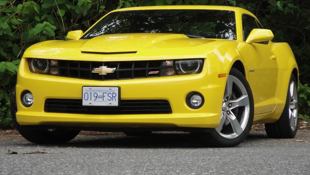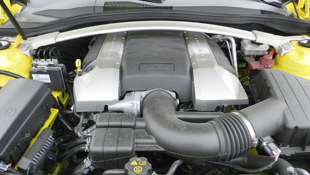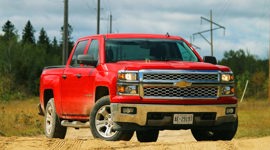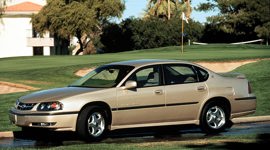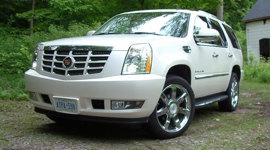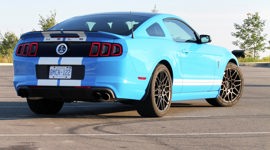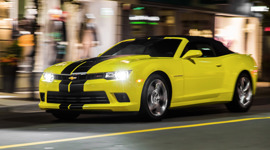Vehicle Type
Most owners love the Camaro’s storied history, stand-out looks, affordable blend of style and performance thrills, decent fuel economy under lighter-footed driving, and highly capable handling and braking on higher-performing models.
Performance Coupe / Convertible
History/Description
Chevrolet rehashed the Camaro badge back in 2010, and this initial generation of the “New Camaro” has often been at or near the top of the segment’s sales charts ever since.
Selection was massive – by way of available six- and eight-cylinder engines, coupe, or convertible body styles, manual or automatic transmissions, and no shortage of special-edition models like the ZL1 and Z28.
All units were two-door four-seaters, and you’ll have little trouble tracking down the model you prefer from the used marketplace.
Feature content included a sunroof, power everything, a head-up display, premium stereo systems, push-button start, automatic climate control, automatic lights, navigation, OnStar, built-in Wi-Fi, and more.
Engines
For V8 power, you’re looking for a Camaro SS, ZL-1, or Z/28. For extra supercharged punch from the most potent factory Camaro, go for the ZL-1. For something a little more affordable and sensible, seek out a Camaro RS, which came with a V6.
The 3.6-litre V6 engine generated as much as 323 horsepower, while the SS got a 6.2-litre V8 with no less than 400 hp (and 26 more when paired with the six-speed manual).
The ZL-1 used a supercharged variant of that engine, good for 580 horsepower, and the lap-time-focussed Z/28 rocked a special 7.0-litre, 505 horsepower V8.
What Owners Like
Most owners love the Camaro’s storied history, stand-out looks, affordable blend of style and performance thrills, decent fuel economy under lighter-footed driving, and highly capable handling and braking on higher-performing models. Feature content favourites include the powerful Bose stereo, and a simple-to-use central command interface.
What Owners Dislike
Common gripes across most models include a low-budget feel to some of the interior trimmings and materials, an awkward driving position that’s been likened to “sitting in a hole”, poor outward visibility, and a sometimes-too-rough ride on some surfaces.
Here are some owner reviews.
Pro Tips
Pre-purchase Inspection
We’ll start with the number-one best thing you can do for maximum peace of mind before buying a used Camaro. That thing? Arrange a pre-purchase inspection (PPI) with your local Chevrolet dealer. You’ll need to have the seller let you bring the vehicle to the dealer, bring it there themselves, or meet you there.
Many used car lots will make arrangements to have the vehicle delivered to a nearby Chevrolet dealer for this inspection on your behalf.
You’ll need to arrange the PPI with the dealership ahead of time (call a few days before, to make an appointment), and expect to pay about $100–$200 for the inspection.
This is literally your best defence against buying someone else’s problems and headaches – and your investment of a few hundred dollars can prevent you from buying a Camaro that’s concealing a few thousands’ worth of problems.
Consumables
For every used Camaro you test drive, approach the vehicle assuming it needs a new clutch, new brakes, and new tires – and that the seller would rather you pick up the bill – until you confirm otherwise.
Fluid Change
Fresh, quality fluids are the life-blood any vehicle. Though we strongly advise against buying a used Camaro without full service records, remember that a full fluid change can go a long way to added peace of mind. If in doubt, change it out: have the transmission fluid, differential fluid, coolant, brake fluid and engine oil replaced pre-emptively, if you’re not certain that they’re fresh. Don’t forget the cabin air filter too – as most owners forget to change this, which can result in problems.
Avoid Mods
Most shoppers are best to avoid a Camaro that’s been modified by a previous owner. In some situations, modifications can negatively affect the durability of the vehicle, cause excessive wear, result in driveline or suspension damage, negatively affect handling, or even void any remaining portion of the vehicle’s warranty.
Note as well that dealers have clever ways to detect the former installation of warranty-voiding engine electronics, meaning that removing the offending modification may still result in a loss of warranty. For maximum peace of mind, stick to stock.
The Test Drive
Supercharger Business
Start by exploring this discussion thread if you’re considering a used Camaro ZL-1 from this generation. Chevrolet dealers were inspecting and replacing superchargers on some units, which may exhibit a loud rattling or grinding sound as a precursor to supercharger failure, or premature wear.
In many cases, owners who have experienced this problem have had it remedied at lower mileage. Determine if the supercharger in the used ZL-1 you’re considering has ever been replaced, where it stands within its warranty period, and whether it’s healthy. Listen to the engine with the hood popped, while the seller revs the engine (and also while you’re driving it) and proceed with extreme caution if any unwanted sounds are detected.
Trickle-charge It
Based on general best practices with modern cars that are typically not daily driven, and on further information from this discussion, shoppers are advised to assess the condition of the battery in their used Camaro and to budget for a trickle charger.
Weak or dying batteries can cause a multitude of problems with on-board electronics, and are often suspect when random electronic issues are detected. Use a trickle-charger when your Camaro will be parked more than a few days at a time for reduced likelihood of headaches.
Skip the V6
For various reasons, our top pick for reliability under the hood is the V8 engine. A not-insignificant number of V6 engines from the same engine family used in this generation of Camaro have had well-documented issues with timing chain problems, oil consumption, and intake valve gunk buildup that can lead to serious issues and are pricey to address.
The Camaro’s V6 engine underwent some updating, though various owners still report that excessive valve gunk, and other headaches, may be an issue. As this is a direct-injection engine, fuel never contacts the intake valves for a cleaning effect, and therefore, no amount of pour-in-tank intake system cleaner will have any effect on solving the gunk problem.
Intake valve gunk can cause hesitation, poor performance, a rough idle, misfiring, and even engine damage. Thousands of owners of V6-powered Camaros have had no issue, though more than a few have – and given that addressing intake valve gunk literally requires dismantling part of the engine, we’d advise sticking with the V8 wherever possible, as it looks to be much more solid from a reliability and complexity standpoint.
If you’re set on a V6 Camaro, be on high alert for hesitation and poor performance during your test-drive, and have the engine computer scanned for a “misfire” code, as a bare minimum. The latter is a common warning sign of valve gunk buildup. During ownership of a V6-powered Camaro, stick strictly to all maintenance intervals outlined in the owner’s manual, use Top Tier fuel at all times, and cut 10,000 kilometres from the factory recommended spark-plug change intervals for maximum peace of mind.
Central Command
If the Camaro’s central command system lags, jams up, crashes, or chokes; a hard reset or software update might be the solution. Run the system through its paces, using the touchscreen to access and manipulate all functions. This may take 10 or 15 minutes. At any sign of trouble, plan to have the unit reset, updated, or re-flashed by the dealer. If neither of these fixes any ongoing issues, the entire unit may have to be replaced.
Further, note that some head-units that didn’t leave the factory with Android Auto can be updated to include this advanced smartphone connectivity feature. Talk to your local dealer to see if Android Auto can be added to the head-unit in the Camaro you’re considering.
Also, here’s some reading on stereo systems that randomly cut out for no apparent reason.
Keys Held Hostage
Some owners have reported ignition switches that may stick on, or fail to release the key, when the vehicle is turned off. Insert, turn, and remove both keys from the ignition (if not equipped with push-button start) several times on your test drive and check for this problem. This may be more likely on models with the automatic transmission. If detected, this problem is best addressed by a dealer technician, who may need to adjust or replace the ignition switch. Here’s some more reading.
Restart When Hot
Numerous owners have reported problems starting the Camaro’s engine if the engine is still hot. After your test drive, shut off the engine for a minute or two, and then restart it. If there’s any hesitation or failure of the restart, note that many owners have had luck installing an additional ground wire to ground the engine block to the chassis. Other owners suspect that the issue may be the result of excessive heat building up in some under-hood component, in certain situations.
Check the Climate Control
Based on this discussion, shoppers are advised to triple-check the operation of the Camaro’s climate control system by ensuring it’s able to quickly deliver powerful heat or cold air on demand. If the system has trouble delivering the selected air temperature from all selected vents, or if some vents unexpectedly blow different temperatures than others, you may want to move to another unit.
Though relatively insignificant against total sales volume, climate control issues including condenser leaks and bad blend doors (which control air distribution) have been reported. The repair of these components, if required, is labour-intensive and may require removal of the vehicle dash. Some owners report that these repairs may also require removal of the windshield, which may need to be replaced once it’s removed from the car.
Translation? If the climate control system in the Camaro you’re considering doesn’t perform flawlessly, you’re likely best to move to another unit.
Finally, note that many climate-control related problems can also be caused by failure of a previous owner to replace their cabin air filter.
Recalls
Here’s a list of recalls. You can check if any of them apply to the vehicle you’re considering by looking up its VIN on the GM website.
Verdict
Most problems reported with this generation of Camaro should be easy to detect on a test drive, and even easier to detect during a 5on (PPI) performed by a trained technician. A V8-powered model with a thumbs-up from the inspecting Chevrolet technician is likely your safest bet.
Safety Ratings
IIHS: N/A
NHTSA: 5/5 Stars (2013)



































